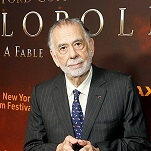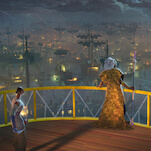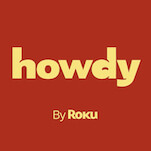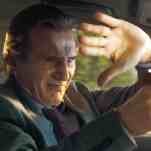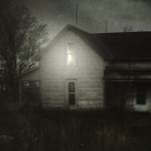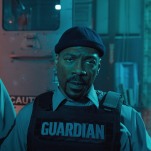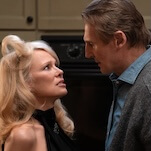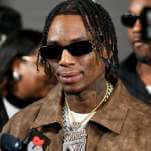That fatalism is especially true of two spin-off miniseries Gaiman wrote about Death, Dream’s irrepressibly fatal sister. Death: The High Cost Of Living and Death: The Time Of Your Life are short, and lack some of the referential playfulness that defines much of Sandman, but the simple philosophy espoused in both (life happens, so go with that) is key to understanding Gaiman’s work. So are other aspects of Sandman and its spin-offs. Many of the ideas and techniques Gaiman still uses today are those he became known for with Sandman, from exploring the flowering of characters’ long-hidden talents to modernizing and revamping old myths, be they ancient gods or half-forgotten existing comic-book characters. The latter dynamic again comes into play in the standalone book The Sandman: The Dream Hunters, in which Dream plays a relatively minor role in a retelling of an old Japanese myth. And the story (beautifully illustrated by Yoshitaka Amano in the original 1999 edition, and bafflingly re-illustrated by P. Craig Russell a decade later) continues to showcase familiar facets of Gaiman’s work: a love of fairy tales, mythic language, and the romanticized folklore of different cultures.
Technically, Gaiman had three novels under his belt already when he wrote 2001’s Hugo- and Nebula-winner American Gods. See below for more on all three, but in brief, Good Omens is a collaboration with Terry Pratchett, Neverwhere an adaptation of his BBC TV series, and Stardust in its current form expands a shorter illustrated work. So as his first solo original novel—and his most literary and ambitious prose work to date—American Gods towers above his other non-comics fiction to such a degree that it feels like a debut. Still, it hews close to ideas Gaiman had already touched upon in Sandman, particularly the concept that all old gods and pantheons tend to hang around, becoming weaker, shabbier, and more desperate as people stop giving them power through faith and worship. And like so many of Gaiman’s works, it draws heavily on folklore, traditions, and religions. It’s certainly possible to read and enjoy this novel without any knowledge of the Norse, Egyptian, or African gods—Gaiman conveniently provides a naïve audience avatar in the form of an ex-con protagonist drawn unwittingly into their world, and discovering it bit by bit—but for the savvy student of myth, American Gods is a rich stew of references and re-imaginings.
Gaiman’s novels are often such ambitious deconstructions of modern mythmaking, but one of his most successful books is a straightforward coming-of-age narrative—even though it’s set in a cemetery, rife with ghosts and monsters, and just happens to be a riff on a century-old children’s story. 2009’s The Graveyard Book is about a little boy named Nobody Owens. After his parents are killed, Nobody is raised by the friendly haunts of the titular cemetery. He learns lessons, faces dangers, and grows old enough to want to see the world beyond his home. Basically, it’s The Jungle Book, but with spooks and specters in place of panthers, snakes, and bears. The simplicity is the key, though, because Gaiman uses the structure of Rudyard Kipling’s story to refine his usual concerns to their essence. Death is presented as a part of life and maturity as the willingness to risk the safety of home for what lies beyond the next horizon.
Somewhat similarly, in 2002, Gaiman made a foray into the young-adult-fiction market with Coraline, a story about a moody tween who resents her parents for (among other things) moving her to a creepy small town, far from her friends. Then Coraline stumbles upon a portal to another world, where she finds versions of her mother and father who love her dearly—suffocatingly so. The situation is fantastical and even grim, but Gaiman keeps it grounded in recognizable adolescent emotions and reactions. The story has been adapted as a graphic novel, a stage musical, and a terrific, Oscar-nominated 3-D movie directed by Nightmare Before Christmas animator Henry Selick. Like the book, the movie Coraline is visionary, cranky, and enveloping, and like Gaiman’s most accessible work, it’s a modern-feeling fantasy story as knotty and moody as a classic fairy tale.
Given Gaiman’s semi-mystical approach to mortality, it’s not surprising that his take on the end of the world would be optimistic. The 1990 novel Good Omens: The Nice And Accurate Prophecies Of Agnes Nutter, Witch is his first novel, written in collaboration with Terry Pratchett, a fantasy writer who shares some of Gaiman’s views on good, evil, and all the colors in between. Pratchett is a brilliant parodist, so it’s no surprise that Omens is funnier than Gaiman’s usual work. What is surprising, and important, is that even when he’s working with another author, Gaiman’s big ideas come across. Omens focuses on the hunt for a misplaced antichrist, and one of the novel’s best (and sweetest) gags is that the so-called world-destroyer, having been raised in ignorance by a perfectly loving, normal family, has no real interest in ending anything. If Sandman was, in part, about the inevitability of change, Omens shows how that inevitability can be a positive thing, demonstrating the ways that traditional concepts of damnation and sin don’t hold up in the face of human possibility.
The novel Stardust, first published as an “illustrated book” (much like a graphic novel in format, but generally with single-page illustrations surrounded by text, rather than panel breakdowns of pages), also deals with change, particularly the not-uncommon-in-fables idea—again, addressed first in Sandman—that getting something may not be as satisfying as wanting it, particularly when the process of getting it changes a protagonist irrevocably. Inspired by and written to some degree in the style of traditional fairy-tale spinners like Lord Dunsany, Stardust’s many narrative threads spin out in all directions and it sometimes feels distracted or overblown. Yet, in the end, all the pieces come together in a neat, satisfying knot that implies they were more planned than they seemed all along. A 2007 film adaptation directed by Matthew Vaughn (who most recently helmed Kick-Ass) opted for spectacle and comedy over that narrative neatness with mixed results; it’s more approachable, but less effective and less coolly intelligent. And after the delicate, idiosyncratically precise example of Charles Vess’ original Stardust art, Vaughn’s standard-issue live-action adventure felt clumsy and broad.
American Gods was such an ambitious piece of myth-making, it was probably inevitable that Gaiman would return to the world for his next novel. Anansi Boys takes up after the events of Gods, and deals with the tricky business of growing up in a deity’s shadow. While it lacks some of Gods’ scope, the book’s semi-farcical storyline shares a familiar focus on the way myths survive down through the years, and the ways the roles a person is born into can be a tool as well as a cage. More manic and slapstick than much of Gaiman’s prose work, Boys is best viewed as a playful romp on well-established tropes. It’s easily Gaiman’s funniest novel outside of Good Omens, and the humor is much of the point: Sometimes having a laugh really is the only way to handle the world, especially when spider-gods and hungry tigers are involved.
Gaiman and Andy Kubert’s Batman: Whatever Happened To The Caped Crusader? smoothes decades of fragmented Batman mythology out into one meta-story about the power of myth itself, set at a strange wake in which everyone’s story about the deceased contradicts each other. Gaiman is both poking fun at the way the major comic-book publishers continually revise their iconic characters, and celebrating the way those characters’ totemic power survives even the silliest revamp. DC’s collected edition of Whatever Happened To The Caped Crusader? also shows how Gaiman toyed with this same idea during his Sandman heyday, by writing Batman stories that openly relied on the contrivances of superhero comics.
After Alan Moore stretched superhero mythology to its logical utopian endpoint in his Miracleman series, he handed the reins over to Gaiman, who proceeded to explore the ramifications of Moore’s vision of a superhero-controlled society in a series of stories later collected as Miracleman: The Golden Age—which, like nearly all the Miracleman/Marvelman comics of the ’80s and ’90s, is tied up in legal limbo and currently out of print. In The Golden Age, Gaiman deals with how ordinary people process the miraculous changes in a Miracleman-dominated world of technological marvels, and considers whether it’s brought them any real happiness. He also peeks in on the rebels who idolize Miracleman’s archvillain, and even explores the relationships between dead men who have been reincarnated and returned to the world, such as Andy Warhol and Albert Einstein. Gaiman’s Miracleman run is a triumph of imagination that rivals Sandman, and may be the best superhero comic-book series that no one is allowed to buy anymore. (Though there’s something distinctly Gaiman-esque about a treasury of amazing stories kept from public view.)
Advanced
In 1990, DC called Gaiman in to write a neophyte’s introduction to the magical side of the DC universe; he complied with a four-issue miniseries about a bespectacled kid who discovers he’s a powerful magical adept, then receives instruction from wizened elders about the history and proper use of his craft. Proto-Harry Potter significance aside, The Books Of Magic is noteworthy for the way it maps out the vast mystical spaces of the DC Universe, and for the way it positions Gaiman’s usual uncovering-arcana theme in the context of a child who’s both amazed and frightened by how much is going on beneath the surfaces of our world.
After a long stint away from comics, Gaiman accepted Marvel’s invitation to play with the company’s toys, and responded first with the odd Marvel 1602, an eight-issue miniseries that imagines what would happen if a glitch in the timeline caused the Marvel heroes to emerge in Elizabethan times. Though the concept is kooky, Gaiman’s plotting and dialogue is often more stodgy than nimble. Still, the book fits in with Gaiman’s overall mission of refreshing worn-out characters and ideas by repositioning them slightly, so readers remember how and why they work. Gaiman took a different tack with his next Marvel miniseries, The Eternals, a revamp of Jack Kirby’s short-lived (and Gaiman-anticipating) ’70s comic about forgotten deities and the roles they played in shaping the universe. In Gaiman’s version, these deities have been living as humans for decades, and are just now beginning to wake up to who they really are. Much looser in tone than 1602, The Eternals is also about how the wondrous nests within the unexpected.
Along the same lines, one of Gaiman’s first big projects for DC Comics was a re-imagining of the obscure DC heroine Black Orchid: His three-issue Black Orchid miniseries recasts her as an immortal eco-heroine in the Swamp Thing mold. The story is a little too self-serious, but Dave McKean’s painted art is hauntingly beautiful, and Black Orchid is of a piece with other Gaiman superhero stories, in that it sees the hero herself as eternal, no matter how many changes she endures, whether violent and unwanted, or self-selected and gradual.
As previously mentioned, McKean has been a reliable partner to Gaiman over the years, most notably in a trio of short graphic novels that represent Gaiman’s most personal work in comics: 1987’s Violent Cases, 1992’s Signal To Noise, and 1994’s The Tragical Comedy Or Comical Tragedy Of Mr. Punch. The first weaves an anecdote about Al Capone into a story about how a child perceives danger; in the second, a dying filmmaker spends his last days imagining an unmade film about the pre-millennial anxiety of the year 999; and the third uses the classic Punch And Judy show as a filter through which a boy understands his family’s fractured relationships. All three experiment with the comics form in bold ways, while working to show readers how oft-told stories continue to have a real impact on people’s lives.
In Gaiman’s fiction, there are worlds within worlds within worlds, and moving between them is as simple as stepping down the right (or wrong) path, but there’s always a cost. For Richard Mayhew, the price is losing (at least for a little while) everything he ever knew, just to save a girl’s life. Neverwhere started life as a BBC television series created by Gaiman and Lenny Henry, and recently received a comic-book adaptation of its own, but it achieved its greatest fame as a novel. It’s all about finding the London behind the actual one everyone knows about, and there are the expected fairy-tale puzzles to solve and villains to defeat. Neither book nor show entirely lives up to Gaiman’s best work, often feeling like a regurgitation of familiar faces. But it’s still a pleasant, sometimes exciting, occasionally disturbing trip, and the moral is the same as ever: The weird ones are always the ones most worth the time it takes to know them.
[pagebreak]
Miscellany
Spawn is a ridiculous comic book based on a ridiculous premise, but Gaiman’s lone contribution to the series, issue #9, at least tried to give it some kind of depth. Introducing a warrior angel named Angela as an antagonist for the titular anti-hero, and providing more of a history and a potential mentor figure for Spawn, Gaiman briefly sustained the illusion that the comic’s storyline might have some kind of plan, instead of a just being a structure on which to hang floppy-cape drawings. It wasn’t amazing, but it was modestly clever, and there’s the usual questioning of the nature of true good and true evil. The most interesting consequence of the issue wasn’t in the story at all, however, but in the legal battles afterward, as Todd McFarlane, creator of Spawn and many other fine products, went on to use the Gaiman-created characters without paying him any additional money. The full legal story is long, complicated, and not over yet: For the latest, check out the entertaining reportage that Comics Buyers’ Guide editor Maggie Thompson has been posting about the current developments in this case, which as of post time was still awaiting a legal decision.
Gaiman marked time as a pop-culture journalist before he moved into comics, and lucky stalwarts who haunt used bookstores can find the Gaiman name affixed to quickie books about Duran Duran and fantasy novels, among other topics. Anyone interested in that side of Gaiman should make an effort to seek out Don’t Panic, about Douglas Adams and The Hitchhiker’s Guide To The Galaxy. The book covers its subject well, and in a witty style not too far removed from Adams’. Don’t Panic also reveals the heretofore unexplored connections between Adams’ skeptical-but-humane worldview and Gaiman’s own.
Gaiman has produced a fairly random assemblage of short works over the years. His first two anthologies are true miscellanies, particularly the first, Angels And Visitations (1993), which contains poetry, a stray book review, a guest introduction for another book, some vignettes, and a piece of Time Out reportage alongside short stories both conventional and illusive. Much of Angels And Visitations appears again in the more comprehensive Smoke And Mirrors (1998), though for the true completist, it’s worth tracking down the former for oddities like “Webs,” an evocative piece that reads like early George R.R. Martin (circa Sandkings), or “The Case Of The Four And Twenty Blackbirds,” a pun-heavy noir-styled murder mystery about Humpty Dumpty’s death. Recent Gaiman fans who’ve read all his novels but overlooked his short work may be surprised by the subject matter in these collections: Short stories like “Foreign Parts” and “Mouse” (which appear in both books) are more sexually charged than Gaiman’s work normally is, and the latter offers a painful look at abortion. Still, many of the other stories here, particularly “Chivalry” and “Troll Bridge” (again, in both collections) recognizably fit into Gaiman’s familiar style, with old stories (the Holy Grail quest and the Three Billy Goats Gruff, respectively) revitalized and recontextualized, for added humor in the first case and added emotional resonance in both. By comparison, the stories in Fragile Things (2006) tend to be more dryly conceptual and structurally experimental, though again, they alternate with poetry. Gaiman’s latest anthology, M Is For Magic (2007), is intended to be child-friendly; it mostly consists of kid-safe stories from all three previous anthologies, brought together for the audience who found him through Coraline and The Graveyard Book. Given the amount of crossover, M Is For Magic should be inessential, though frustratingly, it includes a few pieces otherwise uncollected in the U.S. at present.
Speaking of kid-safe stories, Gaiman has written a variety of children’s picture books: The Day I Swapped My Dad For Two Goldfish (1998), The Wolves In The Walls (2005), and Crazy Hair (2009) are all illustrated by frequent partner Dave McKean in various styles, while Blueberry Girl (2009) and Instructions (2010) are illustrated by Charles Vess. Two Goldfish and Wolves are of most interest to adult fans; the former is a quirky, slightly eerie, strongly surreal story that fits perfectly with McKean’s frequently unsettling collage art, while Wolves is a slightly more conventional fairy tale about a brave girl who should seem familiar and sympathetic to Coraline readers. Of all of them, though, Blueberry Girl has the most interesting backstory: The text is a sweetly sentimental poem Gaiman wrote for his friend Tori Amos to commemorate her daughter’s birth.
Works derived from his stories aside, Gaiman has only made a few forays into screenwriting; apart from Neverwhere, he wrote one episode of Babylon 5 and worked on the English script adaptation of Hayao Miyazaki’s Princess Mononoke, a film whose deep feelings on old gods clashing with new beliefs has a distinct affinity with his own work. More recently and significantly, he co-scripted the creepy-looking Robert Zemeckis motion-capture film Beowulf, alongside Roger Avary. Attempting to piece out who did what in a collaborative project is always fraught and unlikely to come to much good, but it’s certainly tempting to see Gaiman’s hand in the movie’s various conceptualizations of mythology, from Beowulf’s self-mythologizing (which makes his authentically mighty acts into ridiculously overblown fables) to the circular nature of the story, which ties together causes and effects, sin and punishment, animus and anima, much more neatly than the original poem.
When Steve Bissette’s horror anthology Taboo went under, it left some promising serialized stories in the lurch. Alan Moore’s From Hell and Lost Girls were eventually completed, but since Neil Gaiman and Michael Zulli’s take on the legend of Sweeney Todd had barely gotten underway, they elected to let the project fizzle out rather than keep firing away. It’s difficult to tell what Gaiman and Zulli’s Sweeney Todd was going to be, but based on what they finished—a brief prose history of the story and a lushly illustrated prologue about one of their research trips—the book appeared to be on-track to be another Gaiman meditation on the power of stories across generations. Gaiman has said that he’d like to revive the project at some point, but perhaps not as a comic. Here’s hoping he’s still kicking it around.
If Gaiman does come back to Sweeney Todd, perhaps it’ll be as a filmmaker. In addition to his screenwriting endeavors, Gaiman tried his hand at directing in 2003 with A Short Film About John Bolton, in which he pretends to be making a documentary about his friend, illustrator John Bolton, when he’s actually using Bolton as a fictional character in a haunting story about the dark side of the creative impulse. If anyone could make creativity seem like a gift and a curse all at once, it’s Gaiman, who’s seemingly brimming with ideas, but maintains a rare clarity about the effect those ideas can have once they’re loosed into the world.
The Essentials
1. The Sandman can seem like a hefty time investment for the Gaiman newbie, with 10 volumes in the collection (or four massive hardbound “Absolute” editions), not counting the spin-offs. But Gaiman’s signature work remains as ambitious and entertaining today as it was when it helped change comics in the ’90s, and it can’t be underestimated as a window into the ideas that still shape his work today.
2. Coraline represents a far more approachable entry to Gaiman’s work—it isn’t as diverse and colorful, but its tight, cogent, quietly humorous story comes complete with a taste of the macabre. The film version is terrific, but it’s still no substitute for the original book.
3. American Gods remains Gaiman’s strongest novel to date; all of his work for kids and young adults serves as a gateway drug to this book, which rests on the same foundations, but deepens and broadens them for a more adult experience.
4. Smoke And Mirrors misses out by leaving behind a few key pieces from Gaiman’s earlier anthology, but it’s still a crucial segment of the Gaiman picture, containing the best single-book sampler of his short work. Don’t miss out on “We Can Get Them For You Wholesale,” which feels like a lost Twilight Zone episode, from the logical forward progression of its premise to the shudder-inducing ending.
5. Good Omens is as much a Terry Pratchett novel as a Neil Gaiman novel. But that just makes it a must for fans of Monty Python-esque absurdist comedy and smart re-envisionings of old stories. It was also a compelling first exposure to Gaiman for most non-comics-readers of a certain age, and there’s every reason to believe that future generations who run across it early in their Gaiman-reading careers will be equally enthralled and eager to seek out more of his work.
